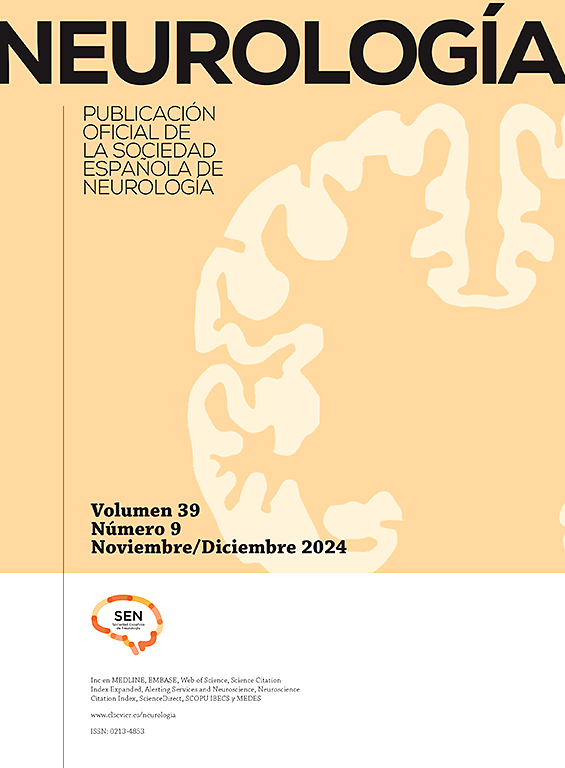迟发性拉斯穆森脑炎:3例说明性病例及文献回顾
IF 3.1
4区 医学
Q2 CLINICAL NEUROLOGY
引用次数: 0
摘要
迟发性拉斯穆森脑炎(late -onset Rasmussen encephalitis, LORE)是一种罕见的单半球进行性炎性疾病,可导致严重的神经功能障碍和耐药性癫痫,发病时间为青春期晚期或成年期。由于现有证据不足,本研究旨在完善其临床特征,总结其特点。三个说明性病例被提出,包括临床,神经生理和神经影像学检查。我们的研究结果与之前通过全面搜索收集到的证据进行了讨论。报告的患者在广泛的年龄范围内呈现成人发病。最初的临床表现是多变的,包括难治性局灶性癫痫、进行性偏瘫和持续部分性癫痫,与先前的研究结果一致。MRI显示进行性半萎缩以额部或后部为主,功能性神经影像学显示广泛的低代谢。如文献所述,在长期随访期间,单脑慢背景活动和癫痫样放电逐渐发展。根据欧洲共识诊断标准,2例患者符合A部分标准,1例符合B部分标准。正如以前的出版物所报道的那样,免疫治疗观察到神经功能下降较慢。结论尽管起病时临床表现广泛,但总体而言,LORE神经功能恶化较轻,免疫治疗反应良好,预后较好。需要进一步的研究来确定最佳策略。本文章由计算机程序翻译,如有差异,请以英文原文为准。
Late-onset Rasmussen encephalitis: 3 illustrative cases and a review of the literature
Introduction
Late-onset Rasmussen encephalitis (LORE) is a rare, unihemispheric, progressive, inflammatory disorder causing severe neurological dysfunction and drug-resistant epilepsy with onset during late adolescence or adulthood. Due to the scarcity of available evidence, this study aims to improve its clinical characterization and summarize the distinctive features.
Development
Three illustrative cases are presented, including the clinical, neurophysiological, and neuroimaging work-up. Our findings are discussed with reference to previous evidence gathered through a comprehensive search.
The reported patients presented adult onset within a wide age range. The initial clinical manifestation was variable, including refractory focal epilepsy, progressive hemiparesis, and epilepsia partialis continua, in line with previous findings. Progressive hemiatrophy with frontal or posterior predominance in MRI and extensive hypometabolism in functional neuroimaging were documented. Unihemispheric slow background activity and epileptiform discharges progressively developed during the long-term follow-up, as described in the literature. According to the European consensus diagnostic criteria, 2 patients met the Part A and one the Part B criteria. As reported in previous publications, slower neurological decline was observed with immunotherapy.
Conclusions
Despite the wide range of clinical manifestations at onset, overall, LORE presents milder neurological deterioration and responds favorably to immunotherapy, which implies a better prognosis. Further studies are needed to establish the best strategy.
求助全文
通过发布文献求助,成功后即可免费获取论文全文。
去求助
来源期刊

Neurologia
医学-临床神经学
CiteScore
5.90
自引率
2.60%
发文量
135
审稿时长
48 days
期刊介绍:
Neurología es la revista oficial de la Sociedad Española de Neurología y publica, desde 1986 contribuciones científicas en el campo de la neurología clínica y experimental. Los contenidos de Neurología abarcan desde la neuroepidemiología, la clínica neurológica, la gestión y asistencia neurológica y la terapéutica, a la investigación básica en neurociencias aplicada a la neurología. Las áreas temáticas de la revistas incluyen la neurologia infantil, la neuropsicología, la neurorehabilitación y la neurogeriatría. Los artículos publicados en Neurología siguen un proceso de revisión por doble ciego a fin de que los trabajos sean seleccionados atendiendo a su calidad, originalidad e interés y así estén sometidos a un proceso de mejora. El formato de artículos incluye Editoriales, Originales, Revisiones y Cartas al Editor, Neurología es el vehículo de información científica de reconocida calidad en profesionales interesados en la neurología que utilizan el español, como demuestra su inclusión en los más prestigiosos y selectivos índices bibliográficos del mundo.
 求助内容:
求助内容: 应助结果提醒方式:
应助结果提醒方式:


